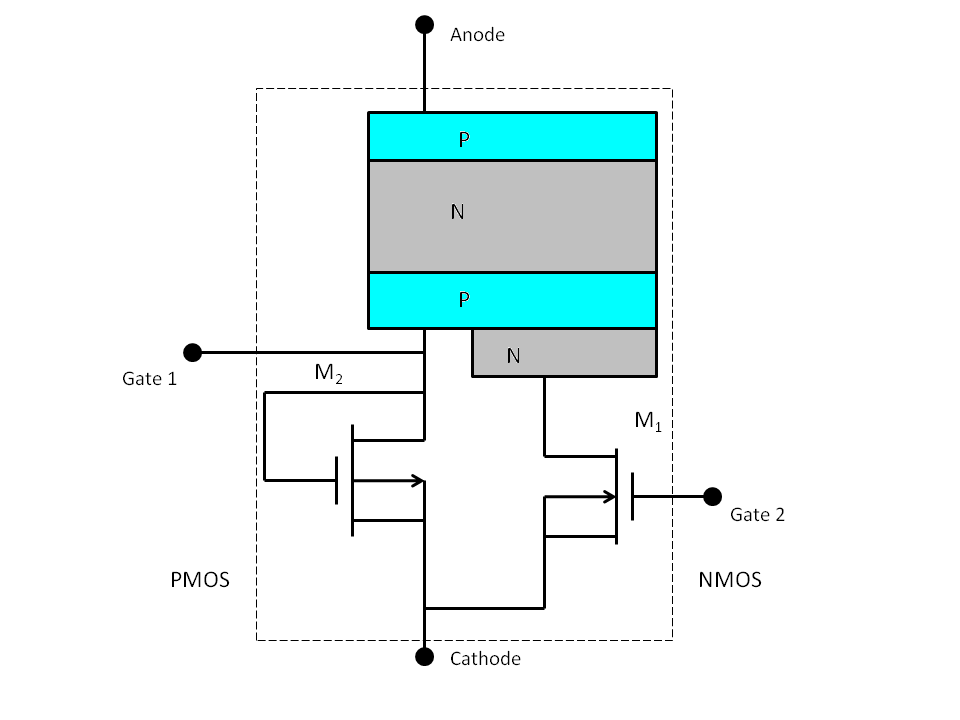Emitter Turn Off Thyristor on:
[Wikipedia]
[Google]
[Amazon]
The Emitter Turn Off Thyristor (ETO) is a type of

 The first generation ETO was developed by Prof. Alex Q. Huang in the Center for Power Electronics, Virginia Tech, in 1996. Although the ETO concept was demonstrated, the first-generation ETO had limitations that prevented high-power applications. The device rating was later improved to 4500V/4000A.
The first generation ETO was developed by Prof. Alex Q. Huang in the Center for Power Electronics, Virginia Tech, in 1996. Although the ETO concept was demonstrated, the first-generation ETO had limitations that prevented high-power applications. The device rating was later improved to 4500V/4000A.

thyristor
A thyristor (, from a combination of Greek language ''θύρα'', meaning "door" or "valve", and ''transistor'' ) is a solid-state semiconductor device which can be thought of as being a highly robust and switchable diode, allowing the passage ...
that uses a MOSFET
upright=1.3, Two power MOSFETs in amperes">A in the ''on'' state, dissipating up to about 100 watt">W and controlling a load of over 2000 W. A matchstick is pictured for scale.
In electronics, the metal–oxide–semiconductor field- ...
to turn on and turn off. It combines the advantages of both the GTO and MOSFET. It has two gates - one normal gate for turn on and one with a series MOSFET for turn off.Rashid, Muhammad H.(2011); ''Power Electronics (3rd ed.)''. Pearson,
History

 The first generation ETO was developed by Prof. Alex Q. Huang in the Center for Power Electronics, Virginia Tech, in 1996. Although the ETO concept was demonstrated, the first-generation ETO had limitations that prevented high-power applications. The device rating was later improved to 4500V/4000A.
The first generation ETO was developed by Prof. Alex Q. Huang in the Center for Power Electronics, Virginia Tech, in 1996. Although the ETO concept was demonstrated, the first-generation ETO had limitations that prevented high-power applications. The device rating was later improved to 4500V/4000A.
Device Description

Turn On
An ETO is turned ON by applying positive voltages togates
Gates is the plural of gate, a point of entry to a space which is enclosed by walls. It may also refer to:
People
* Gates (surname), various people with the last name
* Gates Brown (1939-2013), American Major League Baseball player
* Gates McFadd ...
, gate 1, and gate 2. When a positive voltage is applied to gate 2, it turns on the MOSFET
upright=1.3, Two power MOSFETs in amperes">A in the ''on'' state, dissipating up to about 100 watt">W and controlling a load of over 2000 W. A matchstick is pictured for scale.
In electronics, the metal–oxide–semiconductor field- ...
that is connected in series with the cathode
A cathode is the electrode from which a conventional current leaves a polarized electrical device such as a lead-acid battery. This definition can be recalled by using the mnemonic ''CCD'' for ''Cathode Current Departs''. Conventional curren ...
terminal of the PNPN thyristor
A thyristor (, from a combination of Greek language ''θύρα'', meaning "door" or "valve", and ''transistor'' ) is a solid-state semiconductor device which can be thought of as being a highly robust and switchable diode, allowing the passage ...
structure. The positive voltage applied to gate 1 turns off the MOSFET connected to the gate terminal of the thyristor.
Turn Off
When a turn-off negative voltage signal is applied to the MOSFET connected to the cathode, it turns off and transfers all the current away from thecathode
A cathode is the electrode from which a conventional current leaves a polarized electrical device such as a lead-acid battery. This definition can be recalled by using the mnemonic ''CCD'' for ''Cathode Current Departs''. Conventional curren ...
(N-emitter of the NPN transistor
A transistor is a semiconductor device used to Electronic amplifier, amplify or electronic switch, switch electrical signals and electric power, power. It is one of the basic building blocks of modern electronics. It is composed of semicondu ...
in the thyristor) into the base gate via MOSFET connected to the gate of the thyristor. This stops regenerative latching process and results in a fast turn-off. Both the MOSFET connected to the cathode and MOSFET connected to the gate of the thyristor is not subjected to high-voltage stresses irrespective of the magnitude of the voltage on the ETO, due to the internal structure of the thyristor containing a P-N junction. The drawback of connecting a MOSFET in series is that it has to carry the main thyristor current, and it also increases the total voltage drop by about 0.3 to 0.5V and its corresponding losses. Similar to a GTO, the ETO has a long turn-off tail of current at the end of the turn-off and the next turn-on must wait until the residual charge on the anode
An anode usually is an electrode of a polarized electrical device through which conventional current enters the device. This contrasts with a cathode, which is usually an electrode of the device through which conventional current leaves the devic ...
side is dissipated through the recombination process.
See also
*Thyristor
A thyristor (, from a combination of Greek language ''θύρα'', meaning "door" or "valve", and ''transistor'' ) is a solid-state semiconductor device which can be thought of as being a highly robust and switchable diode, allowing the passage ...
* MOSFET
upright=1.3, Two power MOSFETs in amperes">A in the ''on'' state, dissipating up to about 100 watt">W and controlling a load of over 2000 W. A matchstick is pictured for scale.
In electronics, the metal–oxide–semiconductor field- ...
* Gate turn-off thyristor
A gate turn-off thyristor (GTO) is a type of high-power (e.g. 1200 V AC) thyristor that unlike a normal thyristor is fully controllable and can be turned On and Off by their gate lead.
It was invented by General Electric.
Device descrip ...
References
{{reflist Solid state switches